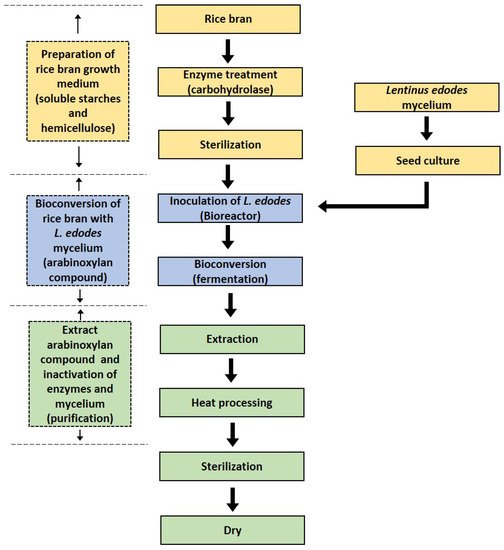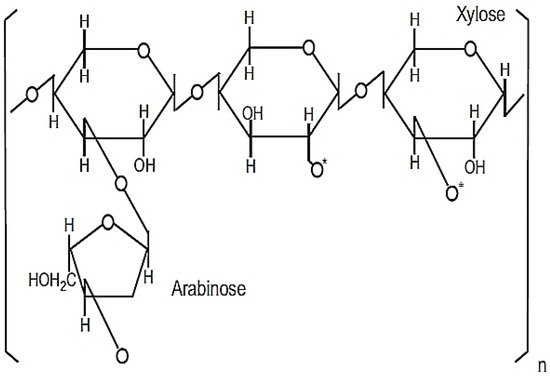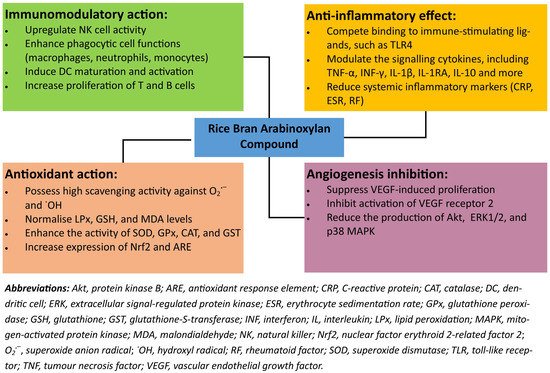Rice bran arabinoxylan compound (RBAC) is derived from defatted rice bran hydrolyzed with Lentinus edodes mycelial enzyme. It has been marketed as a functional food and a nutraceutical with health-promoting properties. Some research has demonstrated this rice bran derivative to be a potent immunomodulator, which also possesses anti-inflammatory, antioxidant, and anti-angiogenic properties. To date, research on RBAC has predominantly focused on its immunomodulatory action and application as a complementary therapy for cancer. Nonetheless, the clinical applications of RBAC can extend beyond cancer therapy.
1. Introduction
Rice bran is the rough brown layer sandwiched between the outer husk of paddy and its endosperm (kernel), as shown in . The bran constitutes roughly 8% of a rice grain before milling and is a source of many nutrients, such as lipids (20–29%), carbohydrates (20–27%, including fibers), proteins (10–15%), B-complex vitamins, minerals, as well as a variety of phytochemicals and antioxidants [1][2][1,2]. Many of the bioactive compounds within rice bran possess cancer-preventing properties, including γ-oryzanol, ferulic acid, caffeic acid, tricin, coumaric acid, phytic acid, tocopherols, phytosterols, and carotenoids [3]. As such, this by-product of rice production is now gaining increasing attention for its nutritional, functional, and commercial potentials beyond its traditional use as animal feed [4]. For instance, there is a growing use of defatted rice bran as a functional ingredient in food production, such as baking, to increase the protein, dietary fiber, and antioxidant contents [5].
Figure 1. Schematic representation of rice before the milling process with the percentage of all its components and the main constituents. Reprinted under CC-BY 4.0 license from Fraterrigo Garofalo S., Tommasi T., & Fino, D. (2021). A short review of green extraction technologies for rice bran oil. Biomass Conv. Bioref., 11, 569–587.
A primary component of the dietary fibers found in rice bran is arabinoxylan, a hemicellulose type belonging to the non-starch polysaccharide group. The structure of arabinoxylan consists of backbone chains of β-(1-4)-linked D-xylopyranosyl (xylan) with α-L-arabinofuranose units linked as side chains via the second and third carbon positions [6]. Along with arabinose, some galactose, xylose, and glucuronic acid residues can also exist as side branches. With a molecular weight ranging between 10 to 10,000 kDa, the cross-links of many side chains make arabinoxylan mostly resistant to extraction by water [7]. Additional treatments using enzymes, alkali solutions or mechanical methods are needed to remove arabinoxylans from the stable cross-link networks to produce soluble hemicellulose and arabinoxylan compounds with low molecular weights [7][8][7,8].
One approach to facilitate the extraction of arabinoxylan from rice bran is via the use of mycelium enzymes. In one study, rice bran was treated with enzymes cultured from nine different fungi types and tested for their macrophage stimulating activities [9]. Treatment with the enzyme from L. edodes (shiitake mushroom) exhibited the highest macrophage stimulating activity. Further research has shown that this rice bran arabinoxylan compound (RBAC) possesses immunomodulating, anti-inflammatory, antioxidant, and anti-angiogenesis properties. From this, RBAC has shown significant potential for clinical applications as a nutraceutical [8].
2. The Production and Composition of RBAC
RBAC is currently available as dietary supplements or nutraceuticals for immune system improvement and disease prevention. Most prominently, a functional food called Biobran MGN-3 is developed in Japan by Daiwa Pharmaceutical Co., Ltd. This product is marketed worldwide under many different brand names, such as Biobran, Ribraxx (in Australia), Lentin Plus (in Asia), or BRM4 (in the United States) [10]. Rice bran exo-biopolymer is another variant of RBAC independently developed in Korea by Erom Co., Ltd. [8][11][12][8,11,12]. It is the main ingredient of Erom’s immune-related products distributed not only in Korea but also in the United States and other countries. This review adopts RBAC as the generic name for any hydrolyzed extract of defatted rice bran modified with the L. edodes mycelial enzyme.
The production of RBAC is depicted in the following .
Figure 2. The steps to produce rice bran arabinoxylan compound: (1) Preparation: Defatted rice bran is enzymatically treated and Lentinus edodes is prepared as a seed culture. (2) Bioconversion: Inoculation of L. edodes as a bioreactor to instigate fermentation. (3) Extraction: The arabinoxylan compound is extracted through heat processing, sterilization and drying.
Biobran Research Foundation [10] described the steps to produce RBAC as follows:
Preparation: Defatted rice bran is thoroughly mixed with hot water at the ratio of 1:5. The insoluble polysaccharide is removed from the mixture leaving only soluble starch. Glucoamylase is then added to hydrolyze the starch by cleaving the 1,4-α-glycosidic bonds of the nonreducing end of the glycosidic chains resulting in the release of d-glucose. This process increases the content of fermentable carbohydrates [13]. L. edodes is cultured in a liquid medium. The mycelia of L. edodes and any insoluble residues are then removed to obtain the carbohydrase complexes, including xylanase, glucosidase, monosidase, and hemicellulose [10].
Bioconversion: This step involves mixing and heating the hemicellulose extract (from rice bran) with the carbohydrase complexes (from L. edodes), resulting in the bioconversion or fermentation of the raw materials.
Extraction: The bioconversion produces partially hydrolyzed rice bran hemicellulose, which has a high arabinoxylan content. The extract is then heated, sterilized, condensed, and added with excipient resulting in the final product as a powder [10].
This powdered product is 98.4% soluble in purified water consisting of heteropolysaccharide structures with molecular weights between 30–100 kDa [14][15][14,15]. The active ingredient responsible for its immunomodulatory property is likely to be a modified arabinoxylan with a xylose in its main chain and an arabinose polymer side chain [14], as shown in .
Figure 3. Chemical structure of MGN-3/Biobran. Reprinted from Wheat and Rice in Disease Prevention and Health, 1st ed., M. H. Ghoneum, Chapter 31—Apoptosis and arabinoxylan rice bran, pp. 401–408, Copyright 2014, with permission from Elsevier.
3. Health-Promoting Properties
3.1. Immunomodulatory Action
RBAC has been promoted as a plant-based biological response modifier that acts to modify the body’s immune response
[16]. RBAC can enhance both innate and adaptive immune systems in eliminating pathogens and malignant cells.
The innate immunity is enhanced via up-regulating the cytotoxic activity of natural killer (NK) cells with increased granularity
[17]. RBAC’s effects on NK cell activity were demonstrated in vivo in different mouse models
[18][19][20][21][22][18,19,20,21,22], in vitro with different cell lines
[11][19][23][11,19,23], and in human trials
[17][23][24][25][26][27][28][29][17,23,24,25,26,27,28,29]. RBAC can also enhance the phagocytic cellular functions of macrophages, neutrophils, and monocytes. Macrophages cultured with RBAC demonstrated better efficacy in phagocytosis, enhanced spreading ability, and increased production of cytokines (tumor necrosis factor-alpha [TNF-
α] and interleukin [IL]-6) to regulate B-cell function
[9][12][30][31][9,12,30,31]. Similarly, neutrophils and monocytes treated with RBAC have also shown enhanced anti-bacterial activity characterized by increased oxidative burst and cytokine production in the presence of bacteria
[32].
RBAC influences the adaptive immune response via the dendritic cells (DCs). Immature DCs derived from peripheral monocytes showed increased expression of maturation markers after treatment with RBAC
[33][34][33,34] The effect of RBAC as a potent inducer of DC maturation and activation has also been confirmed in a placebo randomized control trial (RCT) with 48 multiple myeloma patients
[28][29][28,29]. Activation of DCs also triggers T lymphocyte responses with the increased proliferation of T and B lymphocytes, as revealed in several studies
[17][23][33][35][36][17,23,33,35,36]. In patients with underactive immune systems, RBAC may also enhance immune function by inhibiting the immunosuppression effects of Treg lymphocytes
[36].
3.2. Anti-Inflammatory Effect
The mechanism of how RBAC can trigger the immune-inflammatory response remains unclear. Experiments by Endo and Kanbayashi
[37] have confirmed that molecules of immunoreactive polysaccharides can be detected in blood after oral administration of RBAC. Due to the similarity in structure and molecular weight with lipopolysaccharide from Gram-negative bacteria, it has been suggested that enzyme-treated arabinoxylan may mimic pathogen-associated molecular patterns
[6]. As lipopolysaccharide binds to the toll-like receptor 4 on phagocytes’ surface, low-molecular-weight arabinoxylan may also activate phagocytes through the same receptor
[6]. RBAC administration was shown to exert transient activation of inflammatory cytokines in healthy individuals
[25]. However, in the presence of infection or inflammation, it could down-regulate the overall inflammatory response through competing with pathogens at the immune-stimulating ligands
[6]. Many pre-clinical
[20][22][24][31][32][33][35][20,22,24,31,32,33,35] and clinical studies
[25][28][38][25,28,38] demonstrated RBAC affecting the production of both pro-inflammatory (tumor necrosis factor [TNF]-
α, interferon [INF]-
γ, IL-1
β, IL-2, IL-6, IL-7, and IL-12) and anti-inflammatory (IL-1RA and IL-10) cytokines. Hence, RBAC plays a role in regulating the immuno-inflammatory mechanism by modulating these signaling proteins in a complex multifactorial manner.
The dysfunction of localized inflammatory regulation can lead to chronic and systemic inflammation, which is the underlying cause of many chronic conditions, including asthma, autoimmune conditions, cardiovascular diseases, obesity, diabetes, depression, osteoarthritis, and cancer
[39]. Ichihashi
[40] reported the potential beneficial effect of RBAC on chronic inflammation in a case series. Eight patients with chronic rheumatism on steroids were given RBAC as a food supplement for 6 to 12 months. Three of them responded to RBAC, showing a reduction in rheumatoid factor and C-reactive protein (CRP) post-treatment. Ghoneum and El Sayed
[41] further demonstrated that RBAC has a protective effect against neuroinflammation in a mouse model of sporadic Alzheimer’s disease by lowering IL-6 and intercellular adhesion molecule-1 in brain tissues.
RBAC was also shown in clinical trials to exert effects on lowering the biomarkers for systemic inflammation. A small study (n = 10) that combined RBAC and curcumin reported a potential effect in reducing the raising erythrocyte sedimentation rate in 44% of the participants with early B-cell lymphoid malignancies
[42]. In another study involving patients with mixed-type IBS, supplementation of four weeks with RBAC was shown to have an anti-inflammatory effect by lowering CRP value and the neutrophil-to-lymphocyte ratio
[43].
3.3. Antioxidant Action
RBAC has been shown to augment the function of the antioxidant defense system. Solutions of RBAC in ethanol were assessed by Tazawa et al.
[44] as having a high scavenging rate on hypoxanthine-xanthine oxidase generated superoxide anion radicals, ferrous sulphate-hydrogen peroxide and ultra-violet light reaction system-generated hydroxyl radicals. In an animal study with Ehrlich carcinoma-bearing mice, Noaman et al.
[45] reported that RBAC efficiently suppressed tumor growth with an associated normalization of lipid peroxidation and glutathione contents.
RBAC was also shown to enhance the activity of the endogenous antioxidant scavenging enzymes, which include superoxide dismutase (SOD), glutathione peroxidase (GPx), catalase (CAT) and glutathione-S-transferase (GST), in blood, liver, and tumor tissue
[45]. Similarly, the messenger ribonucleic acid (mRNA) expressions of GPx, SOD1 and CAT in the liver were up-regulated, demonstrating RBAC’s protective properties against oxidative stress
[45].
In another murine model, sporadic Alzheimer’s disease was induced via intracerebroventricular injection of streptozotocin
[41]. After administering RBAC for 21 days, the streptozotocin-treated mouse showed improvement in oxidative stress biomarkers with the significant increase of malondialdehyde and glutathione levels in the hippocampus (
p < 0.0001). Oxidative stress was further studied via the expression of nuclear factor erythroid 2-related factor 2 (Nrf2) and antioxidant response element (ARE). RBAC was shown to increase the hippocampal Nrf2 and ARE levels significantly (
p < 0.0001) in a dose-dependent manner where a high level of RBAC (200 mg/kg) approximately returned the Nrf2 and ARE levels to that of control
[41].
This protective effect against oxidative stress was also shown in another murine study examining gamma radiation’s effects
[46]. Exposure to ionizing radiation is known to induce oxidative stress that can damage cellular macromolecules leading to the demise of hematopoietic tissues
[47]. Mice exposed to gamma radiation showed significant depression in their full blood count, hypocellularity of their bone marrow, and a remarkable decrease in splenic weight. In contrast, pre-treatment with RBAC resulted in protection against such irradiation-induced damages
[46]. RBAC’s ability to augment the antioxidant defense system to counteract the severe adverse effects and toxicity of radiation therapy is confirmed in a double-blind, placebo RCT with head-and-neck cancer patients (n = 65) undergoing radiotherapy by Tan and Flores
[48].
3.4. Angiogenesis Inhibition
RBAC can affect new blood vessel growth through the vascular endothelial growth factor (VEGF) pathway. An in vitro study by Zhu et al. [49] demonstrated that RBAC significantly inhibited VEGF-induced tube formation in human umbilical vein endothelial cells co-cultured with human dermal fibroblasts. Furthermore, RBAC also suppressed the VEGF-induced proliferation and migration of human umbilical vein endothelial cells in a dose-dependent manner [49]. The anti-angiogenic mechanism of RBAC operates through the reduction of not only the VEGF-induced activation of VEGF receptor 2, but also the downstream proteins of protein kinase B, extracellular signal-regulated protein kinase 1/2, and p38 mitogen-activated protein kinase [49]. Therefore, RBAC can potentially mediate angiogenesis, implicated in the pathological progression of conditions such as cancer, cardiac and limb ischemia, diabetic retinopathy, rheumatoid arthritis, and neoplasms [50]. summarizes the medicinal actions and effects of rice bran arabinoxylan compound discussed in this section.
Figure 4. A summary of the key health-promoting attributes of rice bran arabinoxylan compound.




